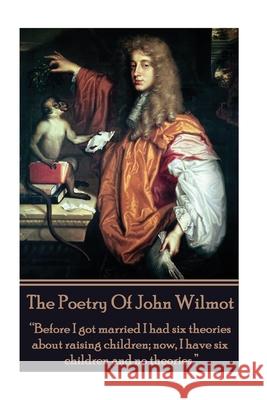The Poetry of John Wilmot: "Before I got married I had six theories about raising children; now, I have six children and no theories." » książka
The Poetry of John Wilmot: "Before I got married I had six theories about raising children; now, I have six children and no theories."
ISBN-13: 9781783942275 / Angielski / Miękka / 2017 / 138 str.
The Poetry of John Wilmot: "Before I got married I had six theories about raising children; now, I have six children and no theories."
ISBN-13: 9781783942275 / Angielski / Miękka / 2017 / 138 str.
(netto: 44,62 VAT: 5%)
Najniższa cena z 30 dni: 46,73
ok. 16-18 dni roboczych
Dostawa w 2026 r.
Darmowa dostawa!
John Wilmot, 2nd Earl of Rochester was born at Ditchley House in Oxfordshire on April 1st 1647. His father was created Earl of Rochester for his services to Charles II including helping him escape to exile. From the age of 7 John was privately tutored and two years later attended school in Burford. At 13 his Father died and Wilmot inherited the title to become 2nd Earl of Rochester. Admitted to Wadham College, Oxford in January 1660 it is said that this was the beginning of his debauched life. In September 1661 he was awarded an honorary M.A. by the newly elected Chancellor of the university, Edward Hyde, Earl of Clarendon......a family friend. As an act of gratitude towards the son of Henry Wilmot, Charles II awarded Rochester an annual pension of 500 and in November 1661 Charles sent Rochester on a three year Grand Tour of France and Italy. Exposure to so much European thinking and writing certainly had an impact on the young Wilmot. In 1664 Rochester returned to London, and made his formal debut at the Restoration court on Christmas Day. Charles II proposed a marriage between Rochester and the wealthy heiress Elizabeth Malet. Her relatives opposed marriage to the impoverished Rochester, who then conspired with his mother to abduct the young Countess. For this the 18 year old Rochester spent three weeks in the Tower, only being released after a penitent apology to the King. Rochester volunteered for the navy in the Second Dutch War in 1665. His courage at the Battle of Vagen made him a war hero. Pleased, Charles appointed Rochester a Gentleman of the Bedchamber in March 1666, which granted him prime lodgings in Whitehall and a pension of 1,000 a year. This inner circle position also meant helping the King to dress and undress, serve his meals when dining in private, and sleeping at the foot of the King's bed. In the summer of 1666, Rochester returned to sea. He again showed extraordinary courage in battle. Upon his return Rochester resumed his courtship of Elizabeth Malet. Defying her family's wishes, Malet eloped with Rochester again in January 1667, and they were married at the Knightsbridge chapel. In October 1667, the monarch granted Rochester special license to enter the House of Lords early, despite being seven months underage. It also helped the King to bolster his number of supporters in the Lords. He was, it is thought, also the lover of Nell Gwyn in her rise to become the King's mistress. Rochester's life was divided between domesticity in the country and a riotous existence at court, where he was renowned for drunkenness, vivacious conversation, and "extravagant frolics" as part of the Merry Gang which flourished for about 15 years after 1665. By now Rochester was increasingly finding disfavour with the King through his escapades and his poems. There is no doubt we was a very fine poet and satirist but also unusually coarse in his both manner and writing and much of the time it was about the King. He was first banished from the court in 1669. He wrote '"With what face can I incline/To damn you to be only mine? ... Live up to thy might mind/And be the mistress of mankind." In 1673 at the Christmas festivities at Whitehall Rochester produced a satire to Charles II, "In the Isle of Britain" - which criticized the King for being obsessed with sex at the expense of his kingdom. It resulted in a further banishment of several months. In June 1675 Rochester again fled the court and yet again in 1676 during a late-night scuffle with the night watch, one of Rochester's companions was killed by a pike-thrust. After hearing of Burnet's departure from his side, Rochester muttered his last words; "Has my friend left me? Then I shall die shortly." In the early morning of 26 July 1680, Rochester died "without a shudder or a sound." John Wilmot, 2nd Earl of Rochester is buried at Spelsbury Church in Oxfordshire.











